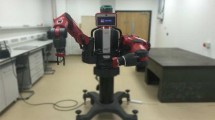Abstract
In this paper, we report techniques for mimicking and evaluating the human motion in real time by a therapeutic humanoid robot to improve the imitation skill of children with autism. For realizing the mimicking technique, we propose a method of selecting key frames using a Q-Learning approach to remove the significant noises. Then, in order to evaluate human motion in real time, we introduce a method of cluster-based framework of Mixture Gaussian and an Expectation-Maximization algorithm using parameters which are converted by Principal Component Analysis. Practical experiments have been performed to test the interaction of children with autism with the robot and evaluate the possibility of improving their imitation skills by training them to perform specific tasks through a robot.
Similar content being viewed by others
References
Wing L (1986) The autistic spectrum. Constable, London
Kozima H, Marek PM, Nakagawa C (2009) Keepon: a playful robot for research, therapy, and entertainment. Int J Soc Robot 1(1):3–18
Robins B, Dautenhahn K, Dubowski J (2006) Does appearance matter in the interaction of children with autism with a humanoid robot? Interact Stud 7(3):509–542
Robins B, Dautenhahn K, Dickerson P (2009) From isolation to communication: a case study evaluation of robot assisted play for children with autism with a minimally expressive humanoid robot. In: The second international conference on advances in computer-human interactions
Michaud F, Laplante J-F, Larouche H, Duquette A, Caron S, Letourneau D, Masson P (2005) Autonomous spherical mobile robot for child-development studies. IEEE Trans Syst Man Cybern, Part A, Syst Hum 35(4):471–480
Feil-Seifer D, Mataric M (2008) B3IA: a control architecture for autonomous robot-assisted behavior intervention for children with autism spectrum disorders. In: The 17th IEEE international symposium on robot and human interactive communication, Munich
De Silva RP, Tadano K, Saito A, Lambacher ST, Higashi M (2009) Therapeutic-assisted robot for children with autism. In: Proceedings of the 2009 IEEE/RSJ international conference on intelligent robots and systems, pp 694–700
Nadel J, Guerini C, Peze A, Rivet C (1999) The evolving nature of imitation as a format for communication. In: Nadel J, Butterworth G (eds) Imitation in infancy, pp 209–234
Andry P, Moga S, Gaussier P, Revel A, Nadel J (2002) Imitation: learning and communication. IEEE Trans Syst Man, Cybern, Part A Syst Hum, 431–442
Shiratori T, Nakazawa A, Ikeuchi K (2006) Synthesizing dance performance using musical and motion features. In: 2006 IEEE international conference on robotics and automation, pp 3654–3659
Riley M, Ude A, Wade K, Atkeson CG (2003) Enabling real-time full-body imitation: a natural way of transferring human movement to humanoids. In: 2003 IEEE international conference on robotics and automation, pp 2368–2374
Bouman CA (2005) CLUSTER: an unsupervised algorithm for modeling Gaussian mixture. Purdue University Technical Report, School of Electrical Engineering, pp 14–20
Yang H-D, Park A-Y, Lee S-W (2007) Gesture spotting and recognition for human-robot interaction. IEEE Trans Robot 23(2):256–270
Author information
Authors and Affiliations
Corresponding author
Rights and permissions
About this article
Cite this article
Fujimoto, I., Matsumoto, T., De Silva, P.R.S. et al. Mimicking and Evaluating Human Motion to Improve the Imitation Skill of Children with Autism Through a Robot. Int J of Soc Robotics 3, 349–357 (2011). https://doi.org/10.1007/s12369-011-0116-9
Accepted:
Published:
Issue Date:
DOI: https://doi.org/10.1007/s12369-011-0116-9




